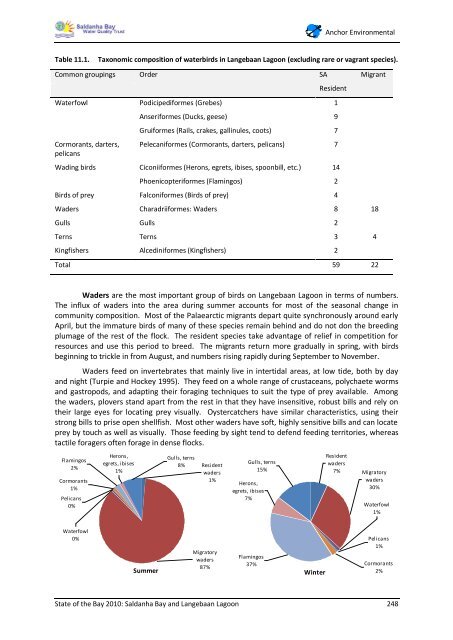State of the Bay Report 2010-Final - Anchor Environmental
State of the Bay Report 2010-Final - Anchor Environmental
State of the Bay Report 2010-Final - Anchor Environmental
Create successful ePaper yourself
Turn your PDF publications into a flip-book with our unique Google optimized e-Paper software.
<strong>Anchor</strong> <strong>Environmental</strong><br />
Table 11.1. Taxonomic composition <strong>of</strong> waterbirds in Langebaan Lagoon (excluding rare or vagrant species).<br />
Common groupings Order SA<br />
Resident<br />
Waterfowl Podicipediformes (Grebes) 1<br />
Cormorants, darters,<br />
pelicans<br />
Anseriformes (Ducks, geese) 9<br />
Gruiformes (Rails, crakes, gallinules, coots) 7<br />
Pelecaniformes (Cormorants, darters, pelicans) 7<br />
Wading birds Ciconiiformes (Herons, egrets, ibises, spoonbill, etc.) 14<br />
Phoenicopteriformes (Flamingos) 2<br />
Birds <strong>of</strong> prey Falconiformes (Birds <strong>of</strong> prey) 4<br />
Migrant<br />
Waders Charadriiformes: Waders 8 18<br />
Gulls Gulls 2<br />
Terns Terns 3 4<br />
Kingfishers Alcediniformes (Kingfishers) 2<br />
Total 59 22<br />
Waders are <strong>the</strong> most important group <strong>of</strong> birds on Langebaan Lagoon in terms <strong>of</strong> numbers.<br />
The influx <strong>of</strong> waders into <strong>the</strong> area during summer accounts for most <strong>of</strong> <strong>the</strong> seasonal change in<br />
community composition. Most <strong>of</strong> <strong>the</strong> Palaearctic migrants depart quite synchronously around early<br />
April, but <strong>the</strong> immature birds <strong>of</strong> many <strong>of</strong> <strong>the</strong>se species remain behind and do not don <strong>the</strong> breeding<br />
plumage <strong>of</strong> <strong>the</strong> rest <strong>of</strong> <strong>the</strong> flock. The resident species take advantage <strong>of</strong> relief in competition for<br />
resources and use this period to breed. The migrants return more gradually in spring, with birds<br />
beginning to trickle in from August, and numbers rising rapidly during September to November.<br />
Waders feed on invertebrates that mainly live in intertidal areas, at low tide, both by day<br />
and night (Turpie and Hockey 1995). They feed on a whole range <strong>of</strong> crustaceans, polychaete worms<br />
and gastropods, and adapting <strong>the</strong>ir foraging techniques to suit <strong>the</strong> type <strong>of</strong> prey available. Among<br />
<strong>the</strong> waders, plovers stand apart from <strong>the</strong> rest in that <strong>the</strong>y have insensitive, robust bills and rely on<br />
<strong>the</strong>ir large eyes for locating prey visually. Oystercatchers have similar characteristics, using <strong>the</strong>ir<br />
strong bills to prise open shellfish. Most o<strong>the</strong>r waders have s<strong>of</strong>t, highly sensitive bills and can locate<br />
prey by touch as well as visually. Those feeding by sight tend to defend feeding territories, whereas<br />
tactile foragers <strong>of</strong>ten forage in dense flocks.<br />
Flamingos<br />
2%<br />
Cormorants<br />
1%<br />
Pelicans<br />
0%<br />
Waterfowl<br />
0%<br />
Herons,<br />
egrets, ibises<br />
1%<br />
Summer<br />
Gulls, terns<br />
8%<br />
Resident<br />
waders<br />
1%<br />
Migratory<br />
waders<br />
87%<br />
Gulls, terns<br />
15%<br />
Herons,<br />
egrets, ibises<br />
7%<br />
Flamingos<br />
37%<br />
Winter<br />
Resident<br />
waders<br />
7% Migratory<br />
waders<br />
30%<br />
Waterfowl<br />
1%<br />
Pelicans<br />
1%<br />
Cormorants<br />
2%<br />
<strong>State</strong> <strong>of</strong> <strong>the</strong> <strong>Bay</strong> <strong>2010</strong>: Saldanha <strong>Bay</strong> and Langebaan Lagoon 248

















